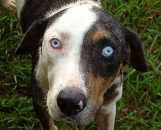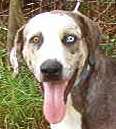Catahoula Issues is a large section of our site.
Please use the links below to navigate the pages within this section.
 I can't count the number of times that I've overheard conversations about what color
eyes determines a "True" Catahoula. Some will say they have to be Blue. Others will say that each eye has to be a different color. In reality, the eye color doesn't make any difference. It's just one
of the things encountered in the genetic make-up of the Catahoula. I can't count the number of times that I've overheard conversations about what color
eyes determines a "True" Catahoula. Some will say they have to be Blue. Others will say that each eye has to be a different color. In reality, the eye color doesn't make any difference. It's just one
of the things encountered in the genetic make-up of the Catahoula.
The eye color of the Catahoula may be Brown, Green, Amber or Blue. Blue is commonly referred to as Glass. The eyes may be of the same color or each eye a different color. The eye may also be of
one color with another color in it. This type of eye is called a "cracked eye." Cracked eyes may be half of one color and half of another, or they may just have a streak or chip of another color.
I've had people tell me that they have had Catahoulas with Gray eyes. If inspected closely, you will learn that although the eye appears gray, it is really a green eye with a mixture of blue in the
eye causing it to give a grayish appearance. This is simply a cracked eye involving the colors green and blue.
Does the eye color make the dog more valuable? No. The value of the dog is placed on the total package, not just the eyes. There have been references that "Glass eyes are preferred" in some of the
standards and writings of individuals, but preferred by whom? The eye color does not make the total dog. Glass eyes are not an attraction that will help you win a show, work better, run farther, hunt
longer, or have a stronger influence in the complete makeup of the dog. Glass eyes are just aesthetics. They are pretty but have nothing else to do with the physical makeup of the dog. Glass eyes is
the result of the Merle gene at work within the dog. It's the same gene that creates the coat colors.
 When checking a dog's eyes, you want to insure that the pupil(black part in the center)
is well rounded, centered, and clear of any other colors. The coloration of the eye is only in the iris, not in the pupil. Any specks of color should be thoroughly investigated. If the pupil shows
any signs of irregularity or shape, this will result in a deduction of points in scoring a dog in a conformation trial. It should be noted that this malformation does mean that your dog will have eye
problems. When checking a dog's eyes, you want to insure that the pupil(black part in the center)
is well rounded, centered, and clear of any other colors. The coloration of the eye is only in the iris, not in the pupil. Any specks of color should be thoroughly investigated. If the pupil shows
any signs of irregularity or shape, this will result in a deduction of points in scoring a dog in a conformation trial. It should be noted that this malformation does mean that your dog will have eye
problems.
The pupil of the eye is like the aperture opening of a camera. It determines the amount of light allowed into the eye. There is no proof that malformed pupils are a transferable genetic problem
similar to deafness. A dog with a malformed pupil is still capable of closing the opening through muscle control and allowing in the amount of light necessary. The pupil will close tightly when it is
exposed to direct light and open wide when in darkened areas. The dog can control that function and enable it to focus and function normally.
Whether or not this is a polygenetic problem or a trick of nature, you should determine the overall characteristics of the dog. If you are looking for a dog that you want to compete in
Conformation Trials, you should eliminate any dog with malformed pupils and eliminate any point deductions in the ring. If you are looking for a dog to compete in Working Trials or a dog that you
want to use for work or hunt, this problem would not be as important as the overall structure and working capabilities of the dog.
If you should suspect that your dog has an eye disease or would like to certify that it is clear of disease you may have them tested and certified by a member of ACVO. Testing will determine that
the eyes are clear of disease and/or malformation; however, the certification is only valid for one year and must be renewed.
For more information on testing and test locations please visit the Canine Eye Registration Foundation (CERF)
|
